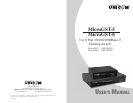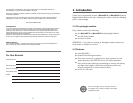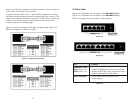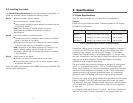
2.3 Installing the switch
The MicroGST-5 and 8 Switches do not need software configuration. To
install the switches, simply complete the following steps:
Step 1
■
Select a location for your switch.
■
Put the switch on a sturdy surface.
■
Keep enough ventilation space between the switch and the
surrounding objects.
Note: When choosing a location, keep in mind the
environmental restrictions discussed in Chapter 3,
Specifications.
Step 2 Connect the switch to network devices
■
Connect one end of a standard network cable to the RJ-45
ports on the back of the switch.
■
Connect the other end of the cable to the network devices
such as printer servers, workstations or routers.
Note: Connection to the Switch requires UTP Category 5 (or
greater) network cabling with RJ-45 plugs. For more
information, please see the Cabling Specification in Chapter
3, Specifications.
Step 3 Supply power to the Switch.
■
Connect one end of the power cable to the switch
■
Connect the power cube end of the power adapter cable to
a standard wall outlet.
When the switch receives power, the POWER LED and the LINK/ACT LED
should remain solid green.
4 5
3. Specifications
3.1 Cable Specifications
Table 3-1 lists the cables you can use and their specifications.
Caution:
Please do not use telephone cables. Telephone cables do not support
Ethernet or Fast Ethernet
Table 3-1 Straight-Through and Crossover Cable Specifications
Twisted-pair cabling comes in various grades, or categories. Category 5
is required for Fast Ethernet, and is also the most reliable and most
commonly used category. You can buy UTP Category 5 (Unshielded
Twisted Pair) Ethernet cabling in pre-crimped lengths, or you can crimp
your own. Crimping your own can result in faulty connections if the RJ-45
plugs are not attached properly. Pre-crimped Category 5 cabling is
available at most computer retail stores.
The most reliable and commonly used type of Category 5 cabling used
is UTP, or “unshielded twisted pair.” STP, or “shielded twisted pair”
wiring is only necessary for network environments exposed to excessive
amounts of electromagnetic interference, or EMI. These environments
include areas with high sources of electrical power, air conditioning,
generators, and radio signals. STP is also used for wiring outdoors.
There are two types of the wiring: Straight-Through Cables and Crossover
Cables. Category 5 UTP/STP cable has eight wires inside the sheath.
The wires form four pairs. Straight-Through Cables have identical pinouts
at both ends while Crossover Cables have a different pin arrangement
at each end.
In a straight-through cable, wires 1,2,3,4,5,6,7 and 8 at one end of the
cable are still wires 1~8 at the other end. In a crossover cable, the
Ethernet Type Cable Requirement Maximum Length
10Base-T Category 3 or above, UTP or STP 328 ft (100M)
100Base-TX Category 5 or above, UTP or STP 328 ft (100M)
1000Base-T Category 5e or above, UTP or STP 328 ft (100M)








